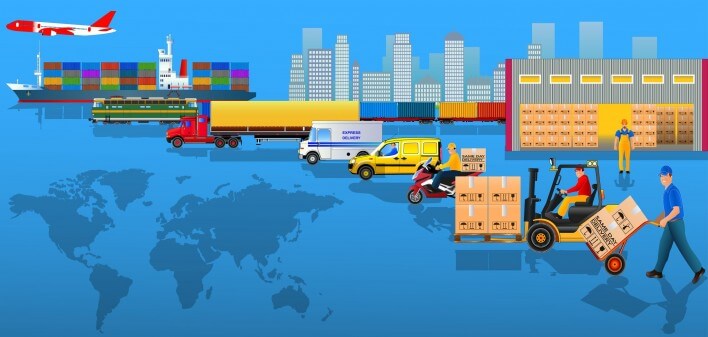National Logistics Law to boost Indian logistics sector

The Ministry of Commerce and Industry is considering replacing the Multimodal Transportation of Goods Act, 1993 (MMTG) with a National Logistics Efficiency and Advancement Predictability and Safety Act (NLEAPS).
- MMTG provides for the regulation of multimodal transportation of goods from India to any place outside India.
- Multimodal transportation refers to a combination of more than one mode of movement, such as rail, road, or sea, for end-to-end delivery of goods.
- It was introduced to facilitate the exporters and give them a sense of security in transporting their goods.
Considering Key Points
- Aim:
- NLEAPS aims to streamline the logistics ecosystem in the country to promote the growth of the sector.
- Modernize and formalize the logistics services and promote digitization in the sector, which is crucial for the smooth movement of goods.
- To reduce the logistics cost from the present 14% of the Gross Domestic Product (GDP) to less than 10% of GDP.
- Reason Behind New Law:
- The new law tends to define various participants of the logistics sector and create a light regulatory ecosystem.
- There is no clear definition of the logistics sector in the MMTG.
- With a market size of USD 160 billion, the logistics sector is complex, with more than 20 government agencies, 40 partnering agencies, 37 export promotion councils, 500 certifications, and 10,000 commodities.
- Benefit:
Effective implementation of the Act would help provide an impetus to trade, enhance export competitiveness, and improve India's ranking in the Logistics Performance Index and Ease of Doing Business.
Introduction –
The Ministry of Commerce in India is considering bringing new policy changes in the Indian logistic sector to introduce new logistic law. The policy change is expected to address various challenges prevailing in cargo movement and different additional costs associated with importers and exporters of goods. The Ministry of Commerce published the draft of the National Logistics Policy on 5th February 2019 to seek suggestions from various stakeholders before finalizing the actual policy. A well-framed logistics law will ensure creating a user-friendly ecosystem that can be a key contributor to powerful economic growth in the country, with a potential to promote domestic and overseas trade, develop global competitiveness, generate adequate employment, and reduce economic inequality.
The Indian logistics sector is highly fragmented and unorganized despite its economic significance. According to Mr. Vikas Anand, the Managing Director, DHL Supply Chain, India, "when one looks at logistics sector in India, and breaks it into various components, and looks at transportation for example within India, it is very fragmented. 55-60% of truck drivers are the owners of the trucks. There are very few organizations, which have a large fleet. The National Logistics Policy will provide greater clarity, which will enable the companies to start investing, which will help the sector to grow.". The Indian Logistics Policy mainly focuses on improving the road network, warehousing, rail corridors, and modern cargo facilities. The policy change will ensure development in the warehousing sector by enhancing the country's storage facilities and promoting cross-regional trade on various e-commerce platforms by a smooth flow of goods. The new logistics plan has the potential to bridge the gap between producers and consumers. The draft policy released by the Commerce Ministry is aimed at reducing logistics costs from 14 percent to less than 10 percent of Gross Domestic Product by 2022. It will enhance India's industrial competitiveness and thus have a positive impact on exports.
The logistics policy will help create a point of reference for all matters relating to logistics and trade, which will also function as an information and knowledge-sharing platform. It will also help create a data and analytics center, which will ensure better transparency and continuous motoring of key logistics metrics. Efficient and practical implementation of the policy would improve India's ranking in the Logistics Performance Index and boost investments. The Logistics value chain is currently managed by various Indian ministries, such as road transport and highways, shipping, railways, civil aviation, and agencies like the Central Drug Standard Control Organization, Food Safety, and Standard Authority of India. The policy aims to bring cooperation between various ministries and have an integration on the central level. The main aim of the policy is to promote the smooth movement of goods across the country.
The recent outbreak of Covid-19 crippled the logistics sector's growth and led to the accumulation of huge losses. Both demand and supply got affected due to the lockdown; the factories were shut, and the sudden migration of workers during the lockdown created a scarcity of skilled laborers. During this hard time, an effective policy change can be a key contributor to the country's economic development, with the potential to facilitate domestic and foreign trade, promote global competitiveness, enhance incomes, support the 'make in India' initiative and reduce economic disparities across various geographies.
The Key Focus Points in Indian Logistic Policy are:
- The integration of the 'Make in India' initiative with the national logistics policy will ensure nationalism and domestic production. It will help in cost reduction and increased exports in the long run.
- Initially, the policy must ensure the balance between imports and exports of materials; the country must relay importing only necessary cost-efficient materials and focus more on enhancing domestic capacities.
- The government's growing focus on infrastructure development under the Make in India initiative will further ensure growth for the logistics sector.
- The policy focuses on public-private partnerships; thus, cooperation will ensure better management.
- The policy also considers various contingencies such as changing economic, social, and political environments.
- The new policy will make India technologically ready to support the policy's objectives on the technical front.
- The policy must ensure focus on key areas such as cybersecurity, data localization, and various sophisticated technological concepts such as artificial intelligence, blockchain, big data, and many more.
- The government is focused on creating various digital platforms and mobile applications for logistics such as warehouse information tracking and trading yard (WITTY) to map the warehouse.
The current state of the industry has been impacting the competitiveness of domestic goods in the international market. The government aims to reduce the logistics cost, which is 14% of the Gross Domestic Product (GDP) at the moment, to less than 10%. This will be expected to create opportunities for the players in the Indian logistics sector.











